UGB162 Human Resource Management Assignment: Contracts and Motivation
VerifiedAdded on 2023/01/09
|16
|3853
|21
Essay
AI Summary
This assignment, created for the UGB162 Introduction to Human Resource Management course, delves into the critical distinctions between contracts of employment and psychological contracts within a business context. It examines the role of psychological contracts in contemporary organizations and evaluates three key content motivational theories, including Maslow's Hierarchy of Needs, in the workplace. The analysis covers the creation, differences, and importance of various contracts, and assesses how these motivational theories can be used to improve employee performance and satisfaction. The essay format provides a structured approach, including an introduction, main body with detailed analysis, and a conclusion summarizing the findings. The paper emphasizes the significance of effective communication and the strategic importance of psychological contracts in fostering a productive work environment. The assignment aims to provide students with a comprehensive understanding of HRM principles and their practical applications.
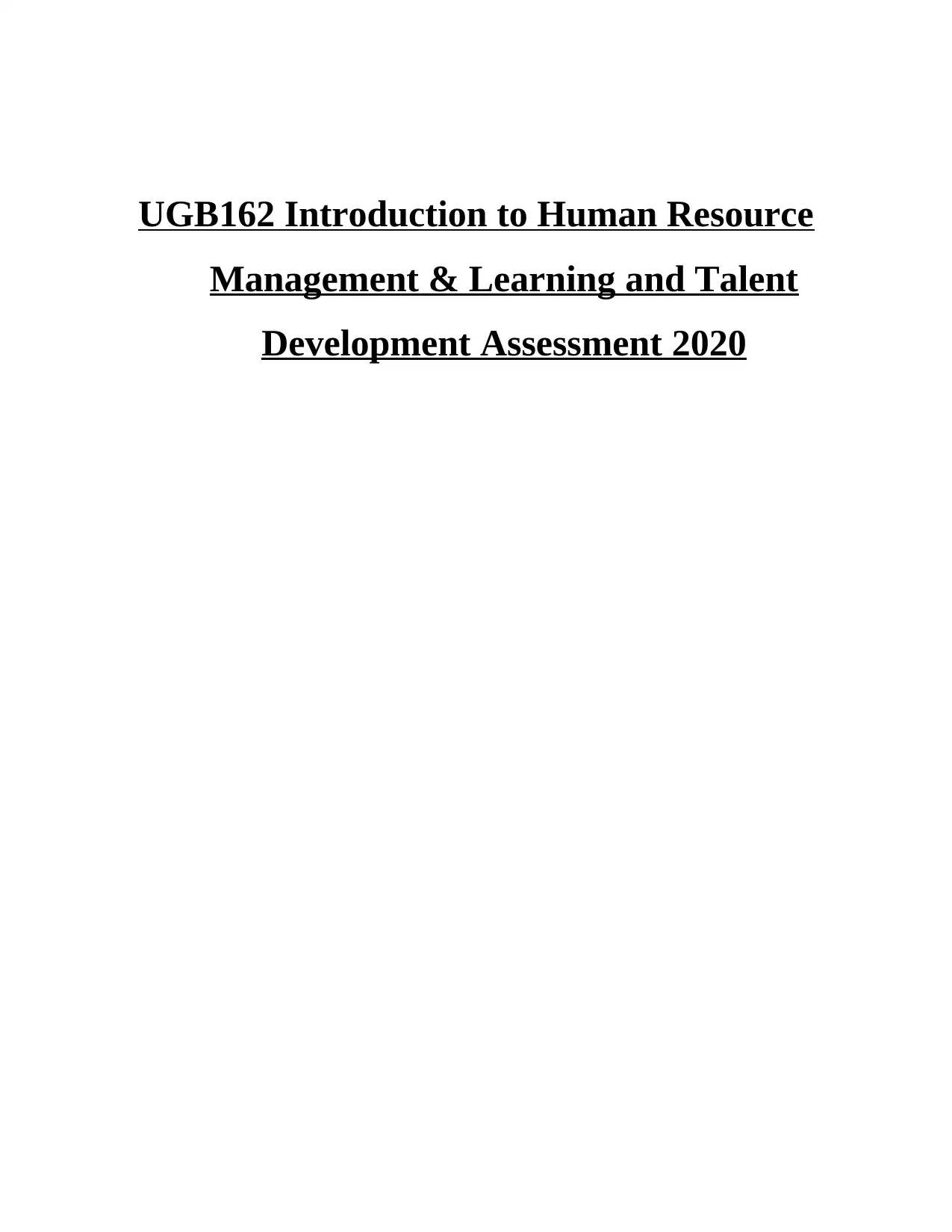
UGB162 Introduction to Human Resource
Management & Learning and Talent
Development Assessment 2020
Management & Learning and Talent
Development Assessment 2020
Paraphrase This Document
Need a fresh take? Get an instant paraphrase of this document with our AI Paraphraser

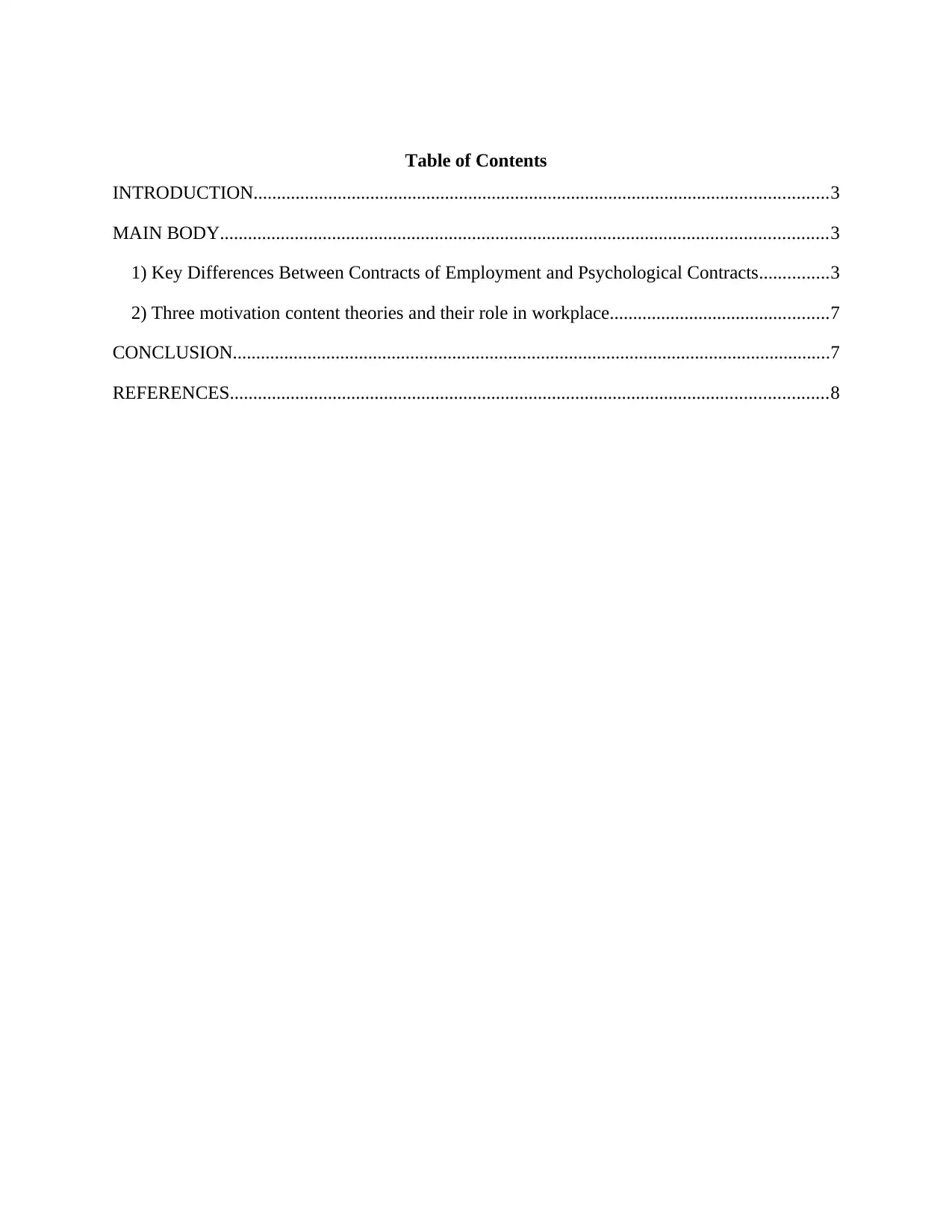
Table of Contents
INTRODUCTION...........................................................................................................................3
MAIN BODY..................................................................................................................................3
1) Key Differences Between Contracts of Employment and Psychological Contracts...............3
2) Three motivation content theories and their role in workplace...............................................7
CONCLUSION................................................................................................................................7
REFERENCES................................................................................................................................8
INTRODUCTION...........................................................................................................................3
MAIN BODY..................................................................................................................................3
1) Key Differences Between Contracts of Employment and Psychological Contracts...............3
2) Three motivation content theories and their role in workplace...............................................7
CONCLUSION................................................................................................................................7
REFERENCES................................................................................................................................8
⊘ This is a preview!⊘
Do you want full access?
Subscribe today to unlock all pages.

Trusted by 1+ million students worldwide
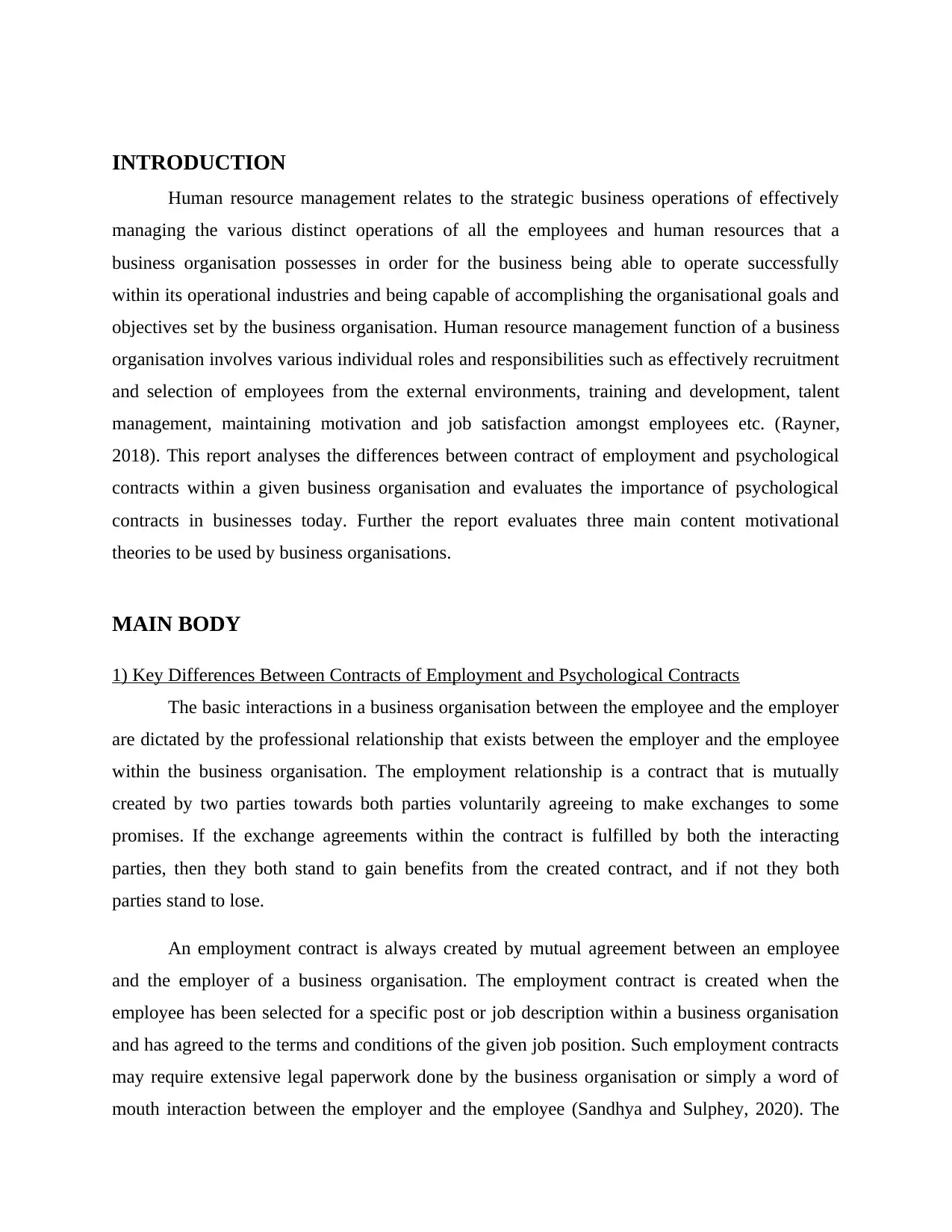
INTRODUCTION
Human resource management relates to the strategic business operations of effectively
managing the various distinct operations of all the employees and human resources that a
business organisation possesses in order for the business being able to operate successfully
within its operational industries and being capable of accomplishing the organisational goals and
objectives set by the business organisation. Human resource management function of a business
organisation involves various individual roles and responsibilities such as effectively recruitment
and selection of employees from the external environments, training and development, talent
management, maintaining motivation and job satisfaction amongst employees etc. (Rayner,
2018). This report analyses the differences between contract of employment and psychological
contracts within a given business organisation and evaluates the importance of psychological
contracts in businesses today. Further the report evaluates three main content motivational
theories to be used by business organisations.
MAIN BODY
1) Key Differences Between Contracts of Employment and Psychological Contracts
The basic interactions in a business organisation between the employee and the employer
are dictated by the professional relationship that exists between the employer and the employee
within the business organisation. The employment relationship is a contract that is mutually
created by two parties towards both parties voluntarily agreeing to make exchanges to some
promises. If the exchange agreements within the contract is fulfilled by both the interacting
parties, then they both stand to gain benefits from the created contract, and if not they both
parties stand to lose.
An employment contract is always created by mutual agreement between an employee
and the employer of a business organisation. The employment contract is created when the
employee has been selected for a specific post or job description within a business organisation
and has agreed to the terms and conditions of the given job position. Such employment contracts
may require extensive legal paperwork done by the business organisation or simply a word of
mouth interaction between the employer and the employee (Sandhya and Sulphey, 2020). The
Human resource management relates to the strategic business operations of effectively
managing the various distinct operations of all the employees and human resources that a
business organisation possesses in order for the business being able to operate successfully
within its operational industries and being capable of accomplishing the organisational goals and
objectives set by the business organisation. Human resource management function of a business
organisation involves various individual roles and responsibilities such as effectively recruitment
and selection of employees from the external environments, training and development, talent
management, maintaining motivation and job satisfaction amongst employees etc. (Rayner,
2018). This report analyses the differences between contract of employment and psychological
contracts within a given business organisation and evaluates the importance of psychological
contracts in businesses today. Further the report evaluates three main content motivational
theories to be used by business organisations.
MAIN BODY
1) Key Differences Between Contracts of Employment and Psychological Contracts
The basic interactions in a business organisation between the employee and the employer
are dictated by the professional relationship that exists between the employer and the employee
within the business organisation. The employment relationship is a contract that is mutually
created by two parties towards both parties voluntarily agreeing to make exchanges to some
promises. If the exchange agreements within the contract is fulfilled by both the interacting
parties, then they both stand to gain benefits from the created contract, and if not they both
parties stand to lose.
An employment contract is always created by mutual agreement between an employee
and the employer of a business organisation. The employment contract is created when the
employee has been selected for a specific post or job description within a business organisation
and has agreed to the terms and conditions of the given job position. Such employment contracts
may require extensive legal paperwork done by the business organisation or simply a word of
mouth interaction between the employer and the employee (Sandhya and Sulphey, 2020). The
Paraphrase This Document
Need a fresh take? Get an instant paraphrase of this document with our AI Paraphraser
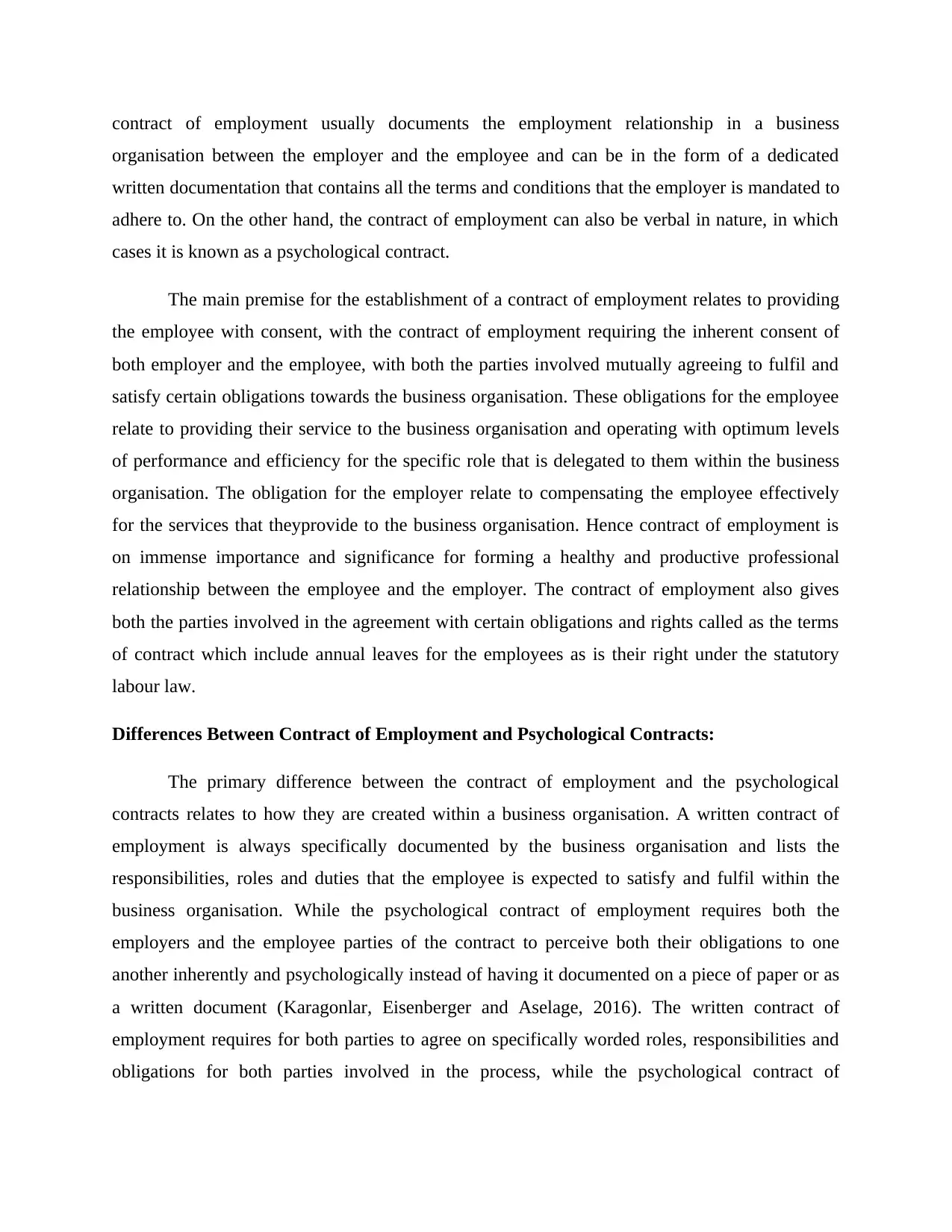
contract of employment usually documents the employment relationship in a business
organisation between the employer and the employee and can be in the form of a dedicated
written documentation that contains all the terms and conditions that the employer is mandated to
adhere to. On the other hand, the contract of employment can also be verbal in nature, in which
cases it is known as a psychological contract.
The main premise for the establishment of a contract of employment relates to providing
the employee with consent, with the contract of employment requiring the inherent consent of
both employer and the employee, with both the parties involved mutually agreeing to fulfil and
satisfy certain obligations towards the business organisation. These obligations for the employee
relate to providing their service to the business organisation and operating with optimum levels
of performance and efficiency for the specific role that is delegated to them within the business
organisation. The obligation for the employer relate to compensating the employee effectively
for the services that theyprovide to the business organisation. Hence contract of employment is
on immense importance and significance for forming a healthy and productive professional
relationship between the employee and the employer. The contract of employment also gives
both the parties involved in the agreement with certain obligations and rights called as the terms
of contract which include annual leaves for the employees as is their right under the statutory
labour law.
Differences Between Contract of Employment and Psychological Contracts:
The primary difference between the contract of employment and the psychological
contracts relates to how they are created within a business organisation. A written contract of
employment is always specifically documented by the business organisation and lists the
responsibilities, roles and duties that the employee is expected to satisfy and fulfil within the
business organisation. While the psychological contract of employment requires both the
employers and the employee parties of the contract to perceive both their obligations to one
another inherently and psychologically instead of having it documented on a piece of paper or as
a written document (Karagonlar, Eisenberger and Aselage, 2016). The written contract of
employment requires for both parties to agree on specifically worded roles, responsibilities and
obligations for both parties involved in the process, while the psychological contract of
organisation between the employer and the employee and can be in the form of a dedicated
written documentation that contains all the terms and conditions that the employer is mandated to
adhere to. On the other hand, the contract of employment can also be verbal in nature, in which
cases it is known as a psychological contract.
The main premise for the establishment of a contract of employment relates to providing
the employee with consent, with the contract of employment requiring the inherent consent of
both employer and the employee, with both the parties involved mutually agreeing to fulfil and
satisfy certain obligations towards the business organisation. These obligations for the employee
relate to providing their service to the business organisation and operating with optimum levels
of performance and efficiency for the specific role that is delegated to them within the business
organisation. The obligation for the employer relate to compensating the employee effectively
for the services that theyprovide to the business organisation. Hence contract of employment is
on immense importance and significance for forming a healthy and productive professional
relationship between the employee and the employer. The contract of employment also gives
both the parties involved in the agreement with certain obligations and rights called as the terms
of contract which include annual leaves for the employees as is their right under the statutory
labour law.
Differences Between Contract of Employment and Psychological Contracts:
The primary difference between the contract of employment and the psychological
contracts relates to how they are created within a business organisation. A written contract of
employment is always specifically documented by the business organisation and lists the
responsibilities, roles and duties that the employee is expected to satisfy and fulfil within the
business organisation. While the psychological contract of employment requires both the
employers and the employee parties of the contract to perceive both their obligations to one
another inherently and psychologically instead of having it documented on a piece of paper or as
a written document (Karagonlar, Eisenberger and Aselage, 2016). The written contract of
employment requires for both parties to agree on specifically worded roles, responsibilities and
obligations for both parties involved in the process, while the psychological contract of
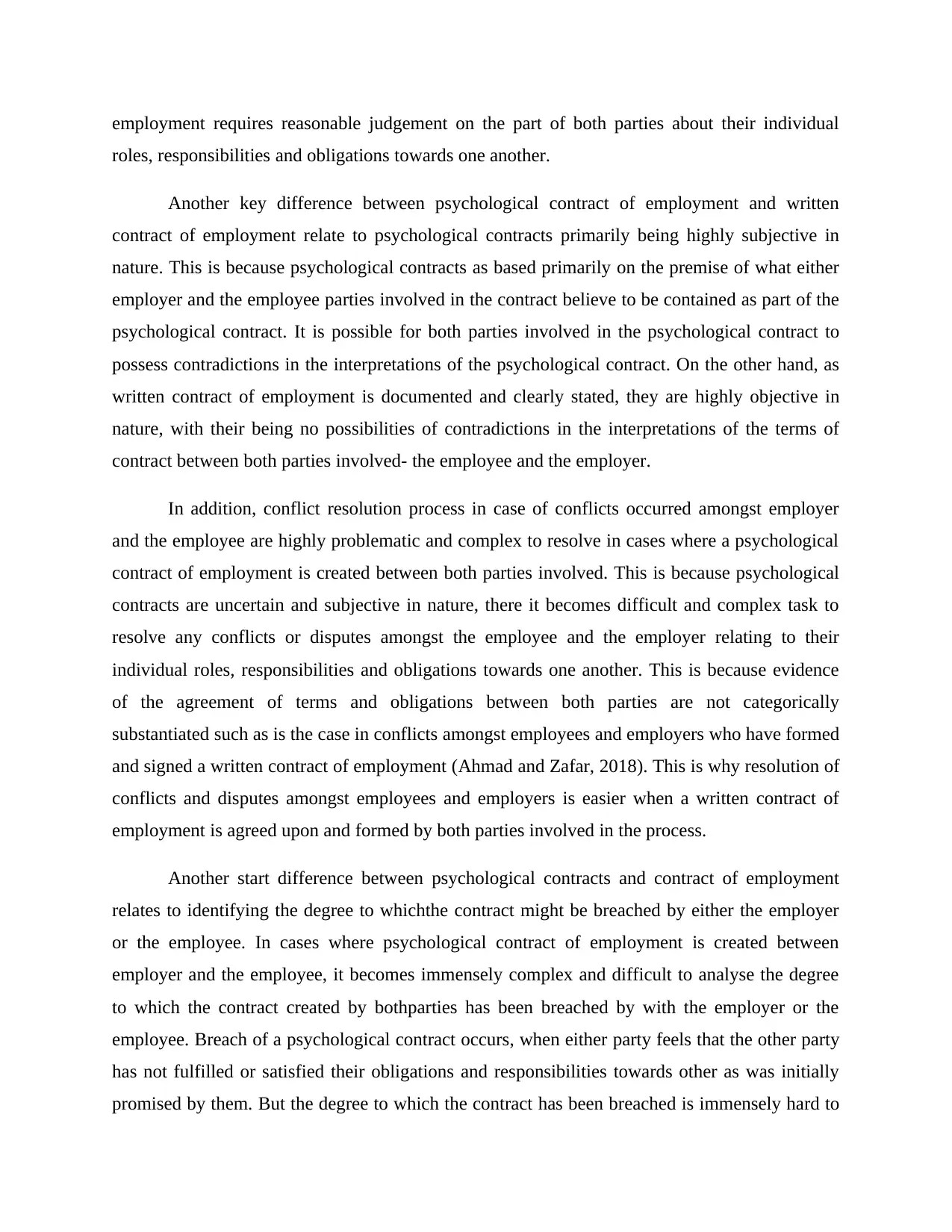
employment requires reasonable judgement on the part of both parties about their individual
roles, responsibilities and obligations towards one another.
Another key difference between psychological contract of employment and written
contract of employment relate to psychological contracts primarily being highly subjective in
nature. This is because psychological contracts as based primarily on the premise of what either
employer and the employee parties involved in the contract believe to be contained as part of the
psychological contract. It is possible for both parties involved in the psychological contract to
possess contradictions in the interpretations of the psychological contract. On the other hand, as
written contract of employment is documented and clearly stated, they are highly objective in
nature, with their being no possibilities of contradictions in the interpretations of the terms of
contract between both parties involved- the employee and the employer.
In addition, conflict resolution process in case of conflicts occurred amongst employer
and the employee are highly problematic and complex to resolve in cases where a psychological
contract of employment is created between both parties involved. This is because psychological
contracts are uncertain and subjective in nature, there it becomes difficult and complex task to
resolve any conflicts or disputes amongst the employee and the employer relating to their
individual roles, responsibilities and obligations towards one another. This is because evidence
of the agreement of terms and obligations between both parties are not categorically
substantiated such as is the case in conflicts amongst employees and employers who have formed
and signed a written contract of employment (Ahmad and Zafar, 2018). This is why resolution of
conflicts and disputes amongst employees and employers is easier when a written contract of
employment is agreed upon and formed by both parties involved in the process.
Another start difference between psychological contracts and contract of employment
relates to identifying the degree to whichthe contract might be breached by either the employer
or the employee. In cases where psychological contract of employment is created between
employer and the employee, it becomes immensely complex and difficult to analyse the degree
to which the contract created by bothparties has been breached by with the employer or the
employee. Breach of a psychological contract occurs, when either party feels that the other party
has not fulfilled or satisfied their obligations and responsibilities towards other as was initially
promised by them. But the degree to which the contract has been breached is immensely hard to
roles, responsibilities and obligations towards one another.
Another key difference between psychological contract of employment and written
contract of employment relate to psychological contracts primarily being highly subjective in
nature. This is because psychological contracts as based primarily on the premise of what either
employer and the employee parties involved in the contract believe to be contained as part of the
psychological contract. It is possible for both parties involved in the psychological contract to
possess contradictions in the interpretations of the psychological contract. On the other hand, as
written contract of employment is documented and clearly stated, they are highly objective in
nature, with their being no possibilities of contradictions in the interpretations of the terms of
contract between both parties involved- the employee and the employer.
In addition, conflict resolution process in case of conflicts occurred amongst employer
and the employee are highly problematic and complex to resolve in cases where a psychological
contract of employment is created between both parties involved. This is because psychological
contracts are uncertain and subjective in nature, there it becomes difficult and complex task to
resolve any conflicts or disputes amongst the employee and the employer relating to their
individual roles, responsibilities and obligations towards one another. This is because evidence
of the agreement of terms and obligations between both parties are not categorically
substantiated such as is the case in conflicts amongst employees and employers who have formed
and signed a written contract of employment (Ahmad and Zafar, 2018). This is why resolution of
conflicts and disputes amongst employees and employers is easier when a written contract of
employment is agreed upon and formed by both parties involved in the process.
Another start difference between psychological contracts and contract of employment
relates to identifying the degree to whichthe contract might be breached by either the employer
or the employee. In cases where psychological contract of employment is created between
employer and the employee, it becomes immensely complex and difficult to analyse the degree
to which the contract created by bothparties has been breached by with the employer or the
employee. Breach of a psychological contract occurs, when either party feels that the other party
has not fulfilled or satisfied their obligations and responsibilities towards other as was initially
promised by them. But the degree to which the contract has been breached is immensely hard to
⊘ This is a preview!⊘
Do you want full access?
Subscribe today to unlock all pages.

Trusted by 1+ million students worldwide
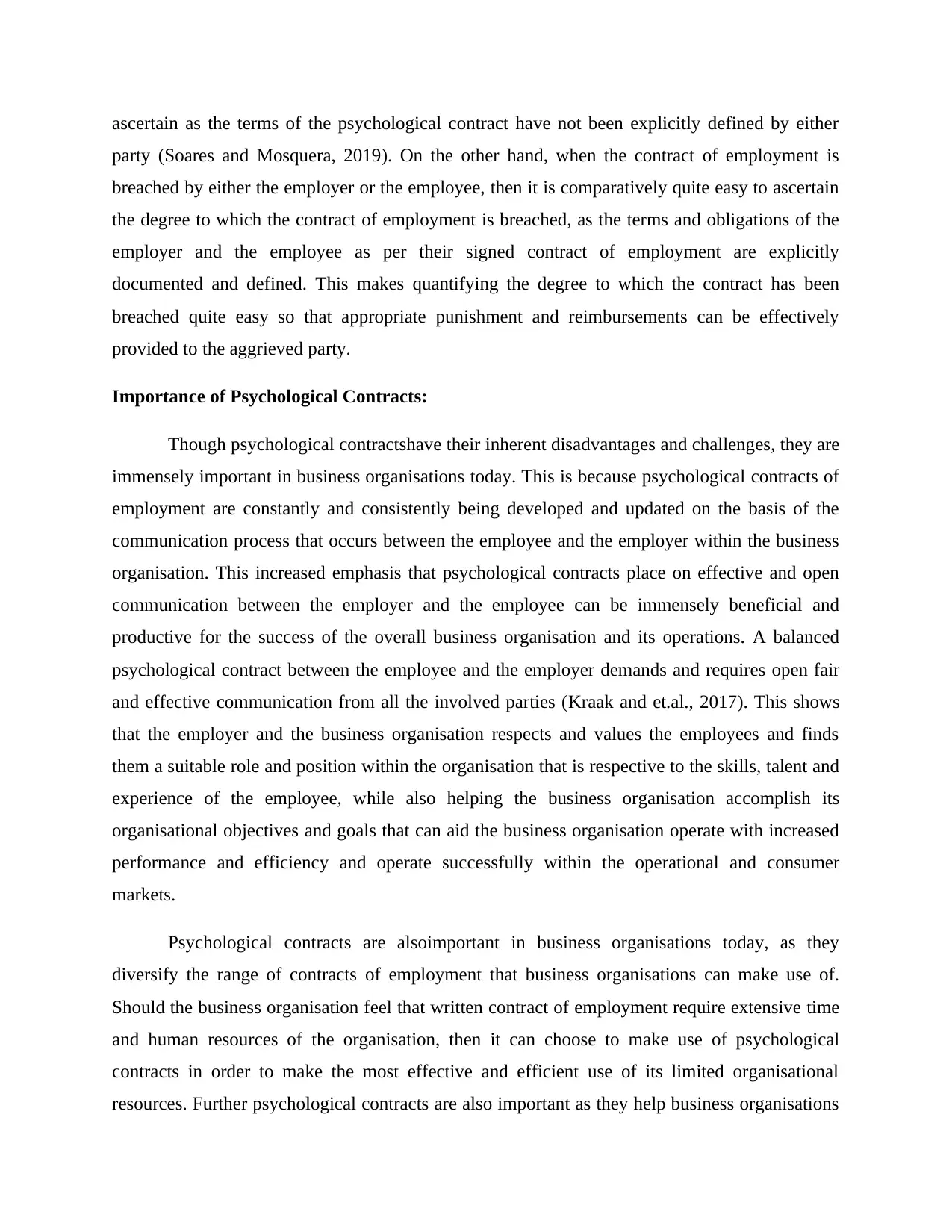
ascertain as the terms of the psychological contract have not been explicitly defined by either
party (Soares and Mosquera, 2019). On the other hand, when the contract of employment is
breached by either the employer or the employee, then it is comparatively quite easy to ascertain
the degree to which the contract of employment is breached, as the terms and obligations of the
employer and the employee as per their signed contract of employment are explicitly
documented and defined. This makes quantifying the degree to which the contract has been
breached quite easy so that appropriate punishment and reimbursements can be effectively
provided to the aggrieved party.
Importance of Psychological Contracts:
Though psychological contractshave their inherent disadvantages and challenges, they are
immensely important in business organisations today. This is because psychological contracts of
employment are constantly and consistently being developed and updated on the basis of the
communication process that occurs between the employee and the employer within the business
organisation. This increased emphasis that psychological contracts place on effective and open
communication between the employer and the employee can be immensely beneficial and
productive for the success of the overall business organisation and its operations. A balanced
psychological contract between the employee and the employer demands and requires open fair
and effective communication from all the involved parties (Kraak and et.al., 2017). This shows
that the employer and the business organisation respects and values the employees and finds
them a suitable role and position within the organisation that is respective to the skills, talent and
experience of the employee, while also helping the business organisation accomplish its
organisational objectives and goals that can aid the business organisation operate with increased
performance and efficiency and operate successfully within the operational and consumer
markets.
Psychological contracts are alsoimportant in business organisations today, as they
diversify the range of contracts of employment that business organisations can make use of.
Should the business organisation feel that written contract of employment require extensive time
and human resources of the organisation, then it can choose to make use of psychological
contracts in order to make the most effective and efficient use of its limited organisational
resources. Further psychological contracts are also important as they help business organisations
party (Soares and Mosquera, 2019). On the other hand, when the contract of employment is
breached by either the employer or the employee, then it is comparatively quite easy to ascertain
the degree to which the contract of employment is breached, as the terms and obligations of the
employer and the employee as per their signed contract of employment are explicitly
documented and defined. This makes quantifying the degree to which the contract has been
breached quite easy so that appropriate punishment and reimbursements can be effectively
provided to the aggrieved party.
Importance of Psychological Contracts:
Though psychological contractshave their inherent disadvantages and challenges, they are
immensely important in business organisations today. This is because psychological contracts of
employment are constantly and consistently being developed and updated on the basis of the
communication process that occurs between the employee and the employer within the business
organisation. This increased emphasis that psychological contracts place on effective and open
communication between the employer and the employee can be immensely beneficial and
productive for the success of the overall business organisation and its operations. A balanced
psychological contract between the employee and the employer demands and requires open fair
and effective communication from all the involved parties (Kraak and et.al., 2017). This shows
that the employer and the business organisation respects and values the employees and finds
them a suitable role and position within the organisation that is respective to the skills, talent and
experience of the employee, while also helping the business organisation accomplish its
organisational objectives and goals that can aid the business organisation operate with increased
performance and efficiency and operate successfully within the operational and consumer
markets.
Psychological contracts are alsoimportant in business organisations today, as they
diversify the range of contracts of employment that business organisations can make use of.
Should the business organisation feel that written contract of employment require extensive time
and human resources of the organisation, then it can choose to make use of psychological
contracts in order to make the most effective and efficient use of its limited organisational
resources. Further psychological contracts are also important as they help business organisations
Paraphrase This Document
Need a fresh take? Get an instant paraphrase of this document with our AI Paraphraser
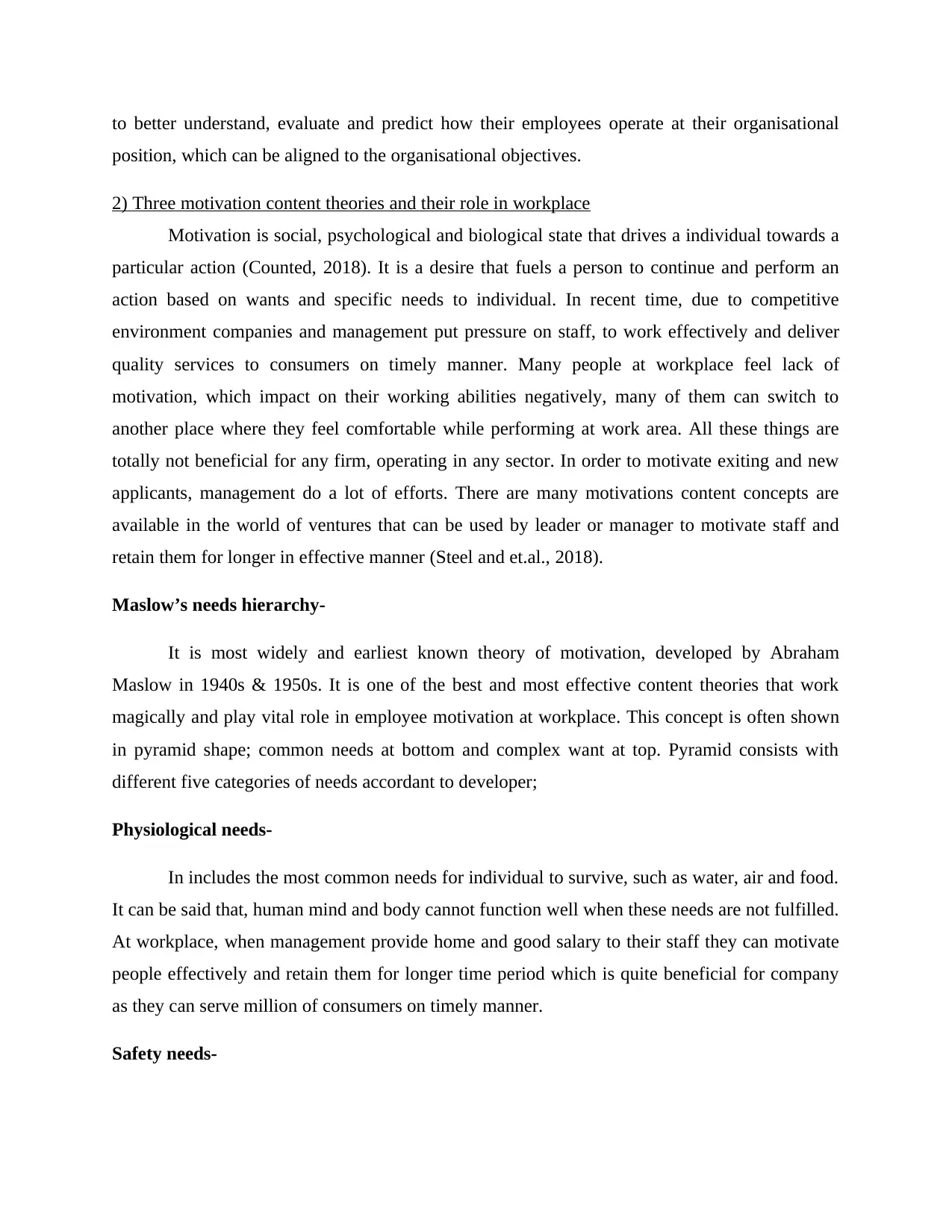
to better understand, evaluate and predict how their employees operate at their organisational
position, which can be aligned to the organisational objectives.
2) Three motivation content theories and their role in workplace
Motivation is social, psychological and biological state that drives a individual towards a
particular action (Counted, 2018). It is a desire that fuels a person to continue and perform an
action based on wants and specific needs to individual. In recent time, due to competitive
environment companies and management put pressure on staff, to work effectively and deliver
quality services to consumers on timely manner. Many people at workplace feel lack of
motivation, which impact on their working abilities negatively, many of them can switch to
another place where they feel comfortable while performing at work area. All these things are
totally not beneficial for any firm, operating in any sector. In order to motivate exiting and new
applicants, management do a lot of efforts. There are many motivations content concepts are
available in the world of ventures that can be used by leader or manager to motivate staff and
retain them for longer in effective manner (Steel and et.al., 2018).
Maslow’s needs hierarchy-
It is most widely and earliest known theory of motivation, developed by Abraham
Maslow in 1940s & 1950s. It is one of the best and most effective content theories that work
magically and play vital role in employee motivation at workplace. This concept is often shown
in pyramid shape; common needs at bottom and complex want at top. Pyramid consists with
different five categories of needs accordant to developer;
Physiological needs-
In includes the most common needs for individual to survive, such as water, air and food.
It can be said that, human mind and body cannot function well when these needs are not fulfilled.
At workplace, when management provide home and good salary to their staff they can motivate
people effectively and retain them for longer time period which is quite beneficial for company
as they can serve million of consumers on timely manner.
Safety needs-
position, which can be aligned to the organisational objectives.
2) Three motivation content theories and their role in workplace
Motivation is social, psychological and biological state that drives a individual towards a
particular action (Counted, 2018). It is a desire that fuels a person to continue and perform an
action based on wants and specific needs to individual. In recent time, due to competitive
environment companies and management put pressure on staff, to work effectively and deliver
quality services to consumers on timely manner. Many people at workplace feel lack of
motivation, which impact on their working abilities negatively, many of them can switch to
another place where they feel comfortable while performing at work area. All these things are
totally not beneficial for any firm, operating in any sector. In order to motivate exiting and new
applicants, management do a lot of efforts. There are many motivations content concepts are
available in the world of ventures that can be used by leader or manager to motivate staff and
retain them for longer in effective manner (Steel and et.al., 2018).
Maslow’s needs hierarchy-
It is most widely and earliest known theory of motivation, developed by Abraham
Maslow in 1940s & 1950s. It is one of the best and most effective content theories that work
magically and play vital role in employee motivation at workplace. This concept is often shown
in pyramid shape; common needs at bottom and complex want at top. Pyramid consists with
different five categories of needs accordant to developer;
Physiological needs-
In includes the most common needs for individual to survive, such as water, air and food.
It can be said that, human mind and body cannot function well when these needs are not fulfilled.
At workplace, when management provide home and good salary to their staff they can motivate
people effectively and retain them for longer time period which is quite beneficial for company
as they can serve million of consumers on timely manner.
Safety needs-
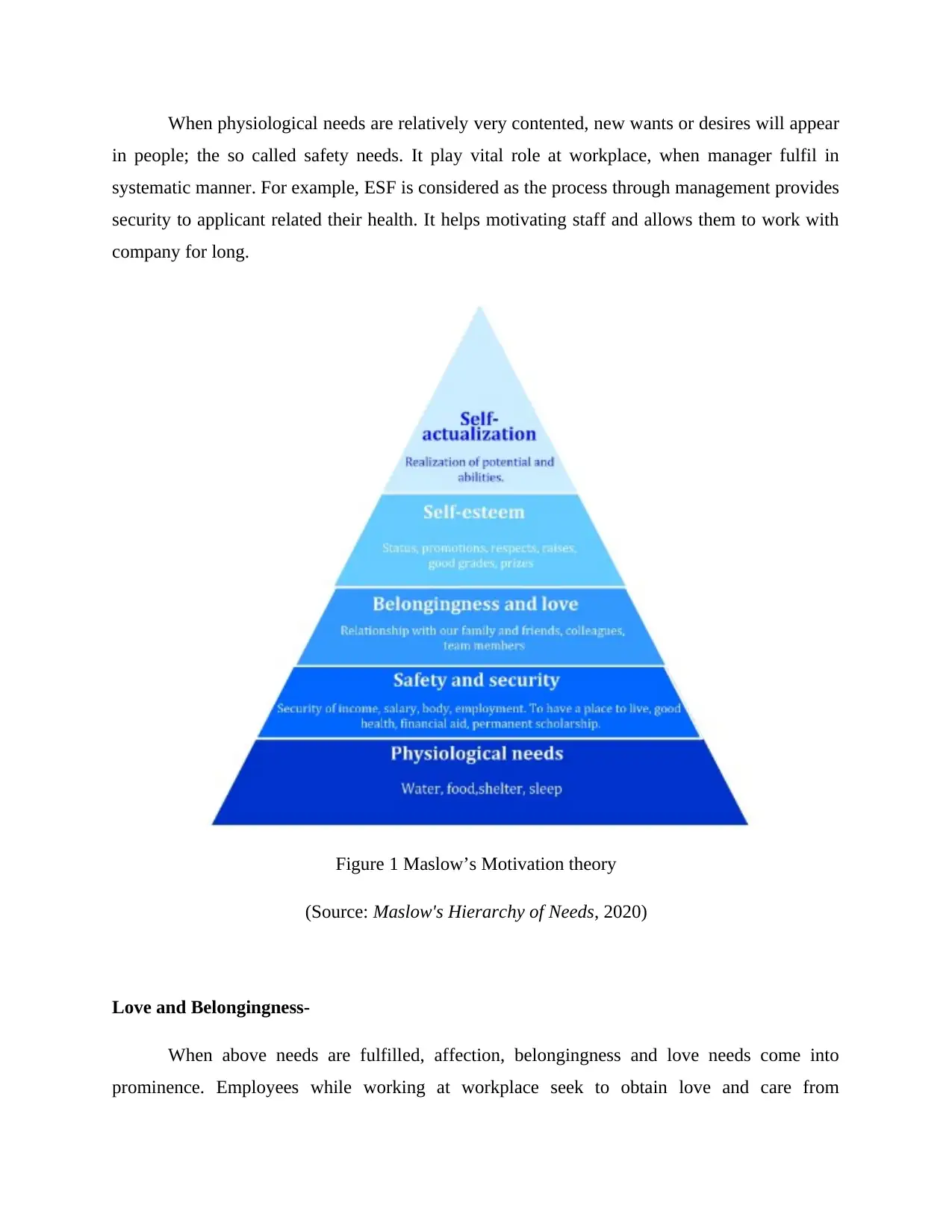
When physiological needs are relatively very contented, new wants or desires will appear
in people; the so called safety needs. It play vital role at workplace, when manager fulfil in
systematic manner. For example, ESF is considered as the process through management provides
security to applicant related their health. It helps motivating staff and allows them to work with
company for long.
Figure 1 Maslow’s Motivation theory
(Source: Maslow's Hierarchy of Needs, 2020)
Love and Belongingness-
When above needs are fulfilled, affection, belongingness and love needs come into
prominence. Employees while working at workplace seek to obtain love and care from
in people; the so called safety needs. It play vital role at workplace, when manager fulfil in
systematic manner. For example, ESF is considered as the process through management provides
security to applicant related their health. It helps motivating staff and allows them to work with
company for long.
Figure 1 Maslow’s Motivation theory
(Source: Maslow's Hierarchy of Needs, 2020)
Love and Belongingness-
When above needs are fulfilled, affection, belongingness and love needs come into
prominence. Employees while working at workplace seek to obtain love and care from
⊘ This is a preview!⊘
Do you want full access?
Subscribe today to unlock all pages.

Trusted by 1+ million students worldwide
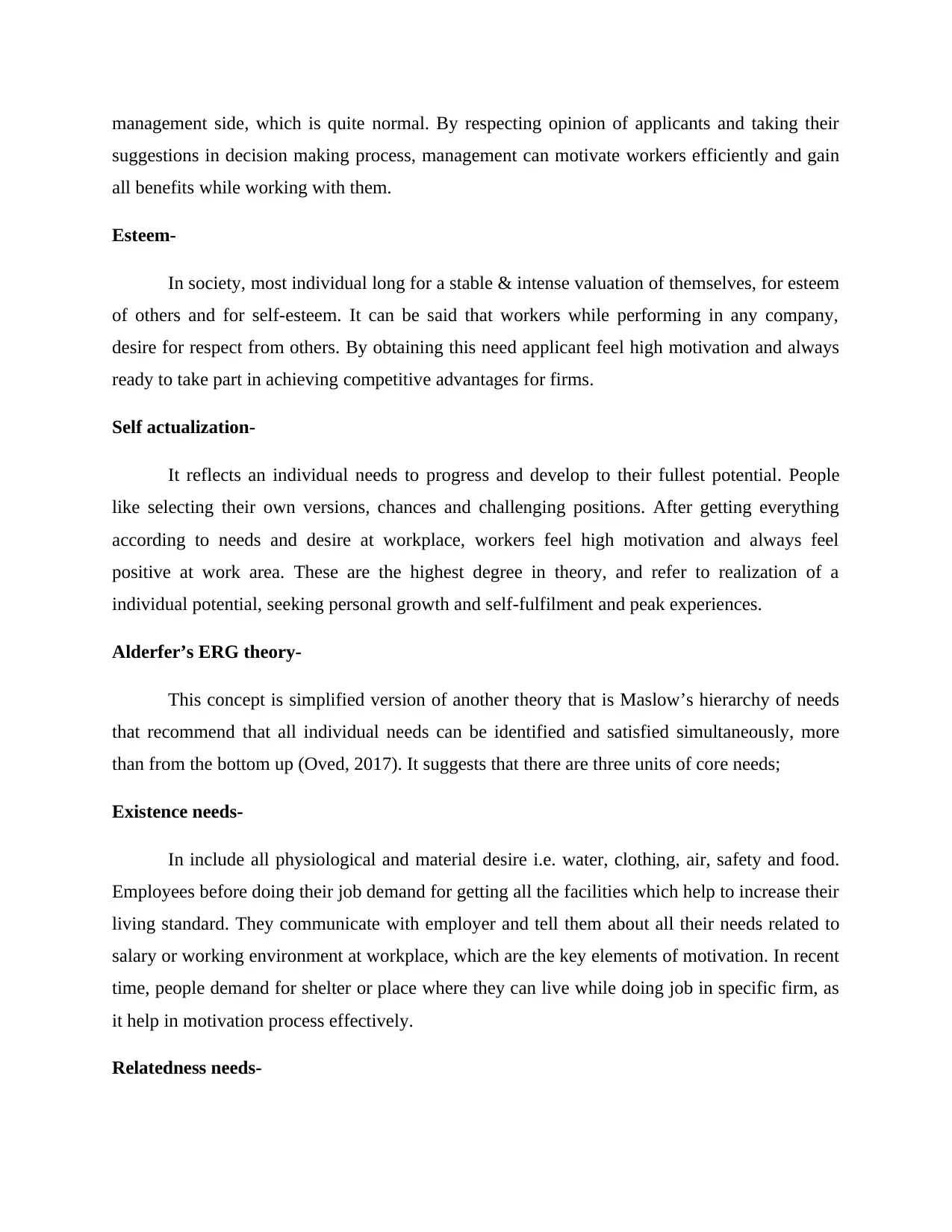
management side, which is quite normal. By respecting opinion of applicants and taking their
suggestions in decision making process, management can motivate workers efficiently and gain
all benefits while working with them.
Esteem-
In society, most individual long for a stable & intense valuation of themselves, for esteem
of others and for self-esteem. It can be said that workers while performing in any company,
desire for respect from others. By obtaining this need applicant feel high motivation and always
ready to take part in achieving competitive advantages for firms.
Self actualization-
It reflects an individual needs to progress and develop to their fullest potential. People
like selecting their own versions, chances and challenging positions. After getting everything
according to needs and desire at workplace, workers feel high motivation and always feel
positive at work area. These are the highest degree in theory, and refer to realization of a
individual potential, seeking personal growth and self-fulfilment and peak experiences.
Alderfer’s ERG theory-
This concept is simplified version of another theory that is Maslow’s hierarchy of needs
that recommend that all individual needs can be identified and satisfied simultaneously, more
than from the bottom up (Oved, 2017). It suggests that there are three units of core needs;
Existence needs-
In include all physiological and material desire i.e. water, clothing, air, safety and food.
Employees before doing their job demand for getting all the facilities which help to increase their
living standard. They communicate with employer and tell them about all their needs related to
salary or working environment at workplace, which are the key elements of motivation. In recent
time, people demand for shelter or place where they can live while doing job in specific firm, as
it help in motivation process effectively.
Relatedness needs-
suggestions in decision making process, management can motivate workers efficiently and gain
all benefits while working with them.
Esteem-
In society, most individual long for a stable & intense valuation of themselves, for esteem
of others and for self-esteem. It can be said that workers while performing in any company,
desire for respect from others. By obtaining this need applicant feel high motivation and always
ready to take part in achieving competitive advantages for firms.
Self actualization-
It reflects an individual needs to progress and develop to their fullest potential. People
like selecting their own versions, chances and challenging positions. After getting everything
according to needs and desire at workplace, workers feel high motivation and always feel
positive at work area. These are the highest degree in theory, and refer to realization of a
individual potential, seeking personal growth and self-fulfilment and peak experiences.
Alderfer’s ERG theory-
This concept is simplified version of another theory that is Maslow’s hierarchy of needs
that recommend that all individual needs can be identified and satisfied simultaneously, more
than from the bottom up (Oved, 2017). It suggests that there are three units of core needs;
Existence needs-
In include all physiological and material desire i.e. water, clothing, air, safety and food.
Employees before doing their job demand for getting all the facilities which help to increase their
living standard. They communicate with employer and tell them about all their needs related to
salary or working environment at workplace, which are the key elements of motivation. In recent
time, people demand for shelter or place where they can live while doing job in specific firm, as
it help in motivation process effectively.
Relatedness needs-
Paraphrase This Document
Need a fresh take? Get an instant paraphrase of this document with our AI Paraphraser
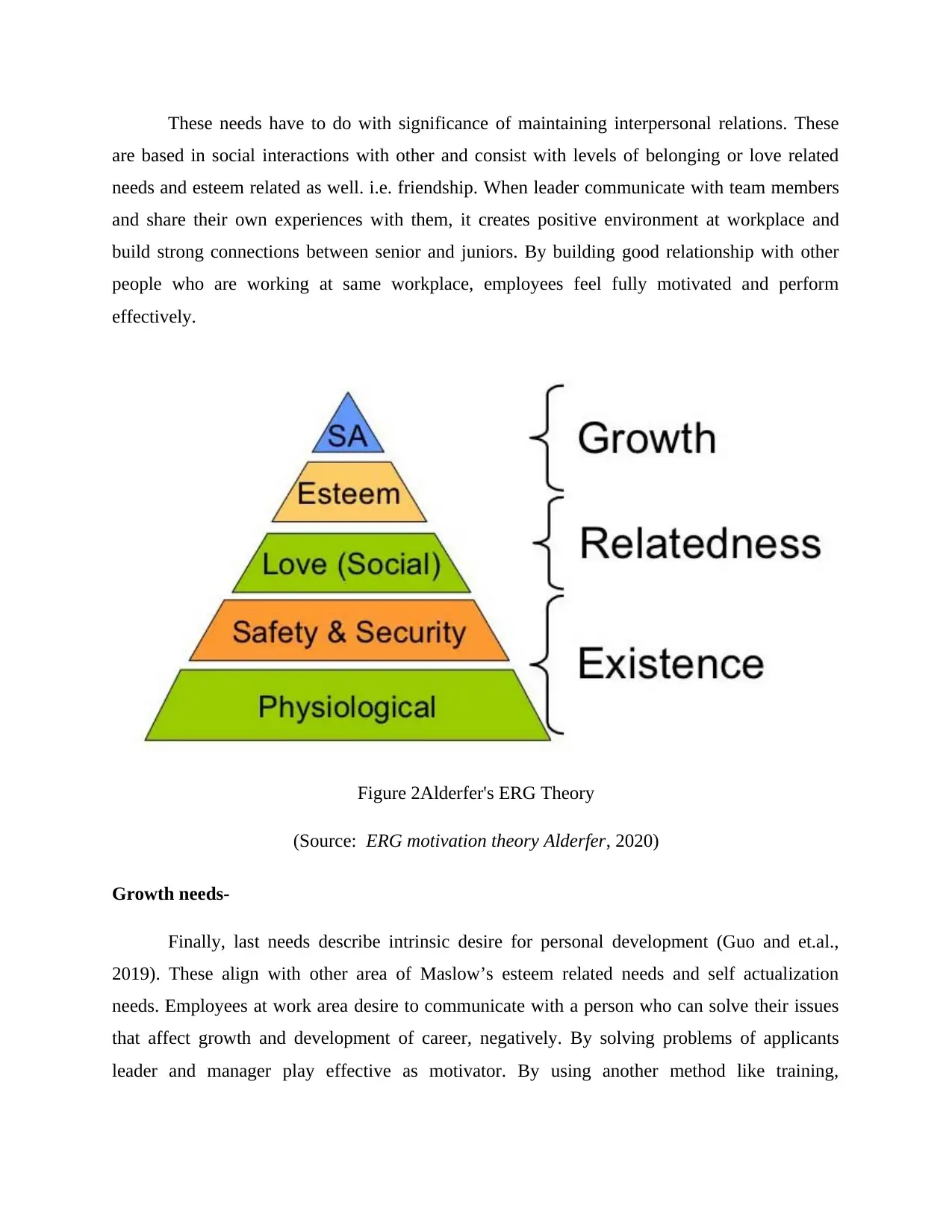
These needs have to do with significance of maintaining interpersonal relations. These
are based in social interactions with other and consist with levels of belonging or love related
needs and esteem related as well. i.e. friendship. When leader communicate with team members
and share their own experiences with them, it creates positive environment at workplace and
build strong connections between senior and juniors. By building good relationship with other
people who are working at same workplace, employees feel fully motivated and perform
effectively.
Figure 2Alderfer's ERG Theory
(Source: ERG motivation theory Alderfer, 2020)
Growth needs-
Finally, last needs describe intrinsic desire for personal development (Guo and et.al.,
2019). These align with other area of Maslow’s esteem related needs and self actualization
needs. Employees at work area desire to communicate with a person who can solve their issues
that affect growth and development of career, negatively. By solving problems of applicants
leader and manager play effective as motivator. By using another method like training,
are based in social interactions with other and consist with levels of belonging or love related
needs and esteem related as well. i.e. friendship. When leader communicate with team members
and share their own experiences with them, it creates positive environment at workplace and
build strong connections between senior and juniors. By building good relationship with other
people who are working at same workplace, employees feel fully motivated and perform
effectively.
Figure 2Alderfer's ERG Theory
(Source: ERG motivation theory Alderfer, 2020)
Growth needs-
Finally, last needs describe intrinsic desire for personal development (Guo and et.al.,
2019). These align with other area of Maslow’s esteem related needs and self actualization
needs. Employees at work area desire to communicate with a person who can solve their issues
that affect growth and development of career, negatively. By solving problems of applicants
leader and manager play effective as motivator. By using another method like training,
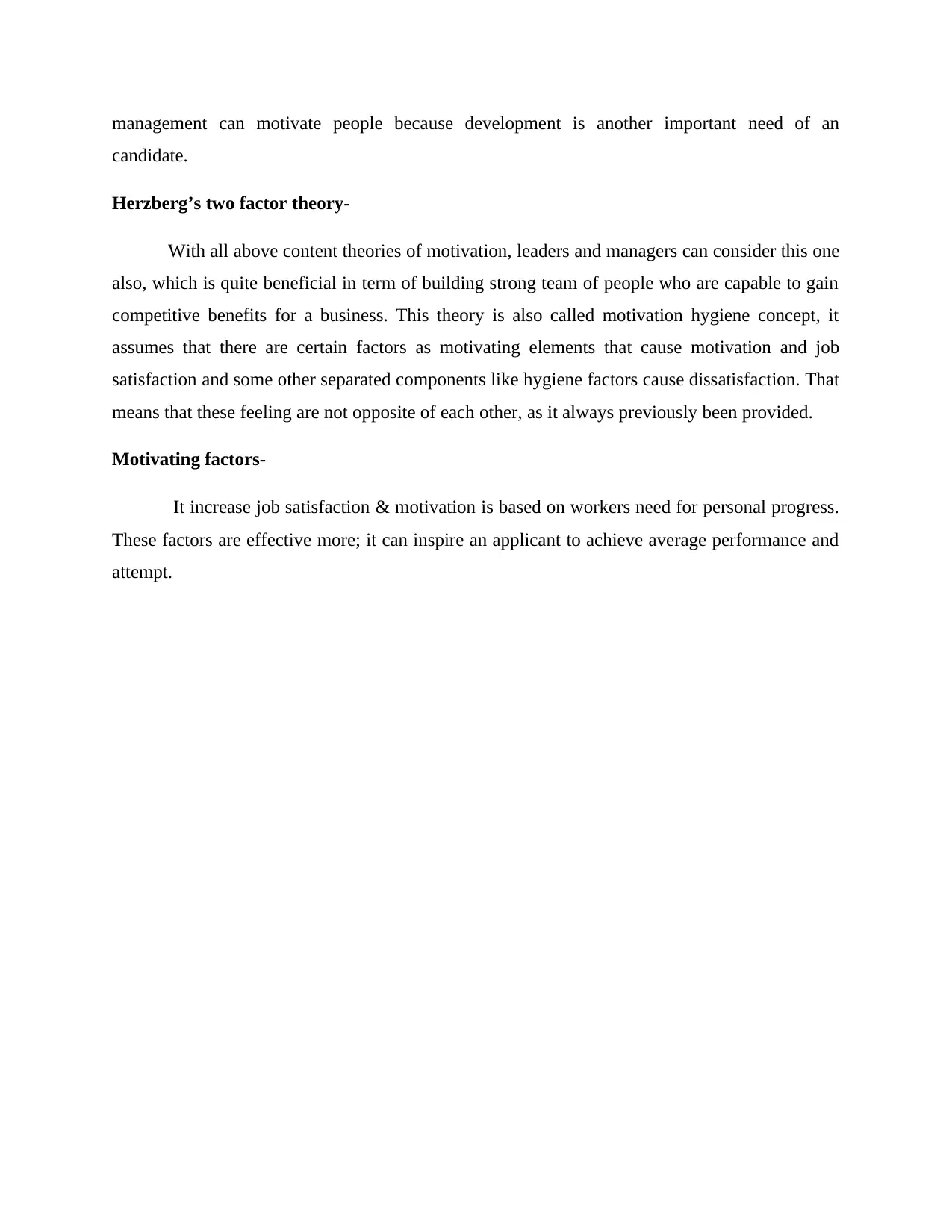
management can motivate people because development is another important need of an
candidate.
Herzberg’s two factor theory-
With all above content theories of motivation, leaders and managers can consider this one
also, which is quite beneficial in term of building strong team of people who are capable to gain
competitive benefits for a business. This theory is also called motivation hygiene concept, it
assumes that there are certain factors as motivating elements that cause motivation and job
satisfaction and some other separated components like hygiene factors cause dissatisfaction. That
means that these feeling are not opposite of each other, as it always previously been provided.
Motivating factors-
It increase job satisfaction & motivation is based on workers need for personal progress.
These factors are effective more; it can inspire an applicant to achieve average performance and
attempt.
candidate.
Herzberg’s two factor theory-
With all above content theories of motivation, leaders and managers can consider this one
also, which is quite beneficial in term of building strong team of people who are capable to gain
competitive benefits for a business. This theory is also called motivation hygiene concept, it
assumes that there are certain factors as motivating elements that cause motivation and job
satisfaction and some other separated components like hygiene factors cause dissatisfaction. That
means that these feeling are not opposite of each other, as it always previously been provided.
Motivating factors-
It increase job satisfaction & motivation is based on workers need for personal progress.
These factors are effective more; it can inspire an applicant to achieve average performance and
attempt.
⊘ This is a preview!⊘
Do you want full access?
Subscribe today to unlock all pages.

Trusted by 1+ million students worldwide
1 out of 16
Related Documents
Your All-in-One AI-Powered Toolkit for Academic Success.
+13062052269
info@desklib.com
Available 24*7 on WhatsApp / Email
![[object Object]](/_next/static/media/star-bottom.7253800d.svg)
Unlock your academic potential
Copyright © 2020–2025 A2Z Services. All Rights Reserved. Developed and managed by ZUCOL.





